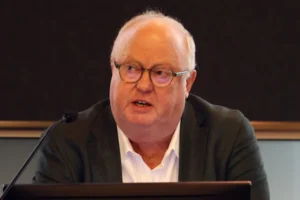
Public hospitals are wasting $1.2 billion a year on avoidable costs such as unnecessary procedures, according to a new report which has landed amid a funding stoush between the states and Commonwealth.
The Grattan Institute report warned Australia’s approach to funding hospitals was “broken” and unrealistic state budgets put hospitals on a yearly “rollercoaster” of blowouts and bail outs.
The report found that while funding had increased by 50 per cent in the last decade, public hospitals were under immense strain with ambulance ramping, longer surgery wait times and burnt-out staff.
The report comes a day after the ABC revealed the prime minister had written to state governments, telling them to rein in hospital spending if they wanted funding agreement honoured.
The letter inflamed tensions as the states and Commonwealth struggle to land a new agreement, but the Grattan report could chart a way forward for negotiations in the future.
“We’re calling for a big reset that works out how to make the system more productive because we know governments are going to have to keep spending more with our aging population and growing rates of chronic disease,” Grattan’s health program director and report co-author Peter Breadon said.
Peter Breadon co-authored the report. (ABC News: Darryl Torpy)
The report warned if hospitals did not curb their spending, governments could impose austerity measures, as seen in the UK, which hurt hospitals and patients.
Some hospitals were also spending too much on avoidable costs such as unnecessarily long hospital stays, pointless tests and scans, procedures not supported by evidence, and under-utilising health professionals like nurses, the report said.
The authors found major differences in cost for the same treatments, with a knee replacement in Victoria varying by almost $14,000 between some hospitals.
There were also big discrepancies in how long patients stayed in hospital, with some staying two days after a knee replacement and some almost 12 days.
All up, the report found improved efficiency could save $1.2 billion each year, or the equivalent of 160,000 hospital visits.
“Cutting costs doesn’t mean cutting quality,” Mr Breadon said.
“There’s a lot of opportunities to scale up best practices, but the problem is the way we fund hospitals really blocks that change.”
The report found large differences in costs for the same treatments across hospitals. (ABC News: Lucas Hill)
State and territory governments commit billions of dollars every year to fund public hospitals but hospitals almost always go over budget.
Mr Breadon said that was because “bogus budgets” were set unrealistically low to drive disciplined spending by the hospitals.
This created a cycle of governments needing to bail out hospitals to keep their doors open and because hospital leaders know their deficits will be covered, there was little incentive for them to prioritise efficiency, he said.
The report also recommended CEOs and board members lose their jobs if they put hospitals in unwarranted deficits.
“This has happened rarely in Australia, it’s happened more in some overseas systems for financial management,” Mr Breadon said.
Call for Commonwealth to contribute more
But in a suggestion likely to please state and territory governments, Mr Breadon said the Commonwealth’s contribution to public hospital funding should rise in line with growing demand for care.
The states and territories have an agreement with the Commonwealth where public hospitals are funded based on how many and what type of patients they treat, which is then adjusted for cost increases. But to put the brakes on spending, the Commonwealth caps annual funding growth at 6.5 per cent.
Under a deal agreed to by national cabinet in 2023, the federal government would increase its share of public hospital funding to 42.5 per cent by 2030, and 45 per cent by 2035.
The federal government also agreed to replace the cap on funding growth with a more “generous approach”, but it has since been revealed that after a one-off catch-up year of 13 per cent, the cap would rise from 6.5 per cent to 8 per cent.
That has been a sticking point in negotiations, with the states saying the caps did not keep pace with demand.
The states and territories are currently in a public hospital funding stoush with the Commonwealth. (ABC News: Keane Bourke)
Mr Breadon agreed the current caps were unrealistic and needed to reflect rising costs.
“When you see massive population growth in a state, it doesn’t give them much room to pay for better care over time and treat more people over time, and when you see a big spike in costs like we saw coming out of the pandemic, it doesn’t take that into account either,” he said.
New South Wales Health Minister Ryan Park told the ABC the issue “keeps me up at night”.
“That causes massive issues in terms of bed block, that causes massive issues in terms of delays and it’s simply not fair and not acceptable in a system that’s meant to be jointly funded equally,” he told Radio National on Tuesday.
Queensland Premier David Crisafulli said bed block was “a national disgrace”.
“The federal government needs to step up and take responsibility for aged care patients and disability patients stranded in public hospitals,” he said in state parliament on Tuesday.
Mr Breadon said the Commonwealth should pay for temporary solutions when patients waiting for aged care or disability accommodation were stuck in hospital.
How else could money be saved?
To try to minimise price variation between hospitals, the report called on the independent health pricing authority to set prices which reflect the true cost of efficiently providing treatments.
It recommends hospitals be paid more if they send patients home on the same day as their treatment rather than keeping them in for multi-day stays. This incentive is already in effect in other countries like the UK.
Currently hospitals in Australia get a lower payment if they send someone home on the same day for many procedures.
“In Australia, less than 1 per cent of people go home the same day they turned up [for a hip or knee replacement] but in Canada, that’s closer to one in five,” Mr Breadon said.
Australian Medical Association president Danielle McMullen said some public hospitals had trialled the same-day discharge model for joint replacements.
“We’re really keen to see more exploration of this where clinically appropriate — it’s about incentivising hospitals to think innovatively and to perform to the best of their ability rather than taking a punitive approach.”
Danielle McMullen would like to see “more exploration” of the same-day discharge model for joint replacements, where appropriate. (Supplied: AMA)
Dr McMullen said the Grattan report showed hospitals needed to be as productive as possible but also be empowered.
“The Commonwealth needs to stick to its promises on funding and the states and territories need to have discussions about how to improve performance [because] the cost of medical care continues to increase.”





